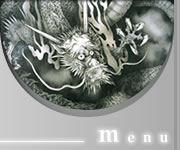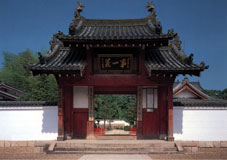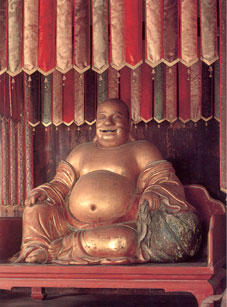

|
Top >
Head Temples - Manpuku-ji Temple
Head TemplesTemple Name: Manpuku-ji 萬福寺Mountain Name: Obaku-san 黄檗山Address: 34 Samban-wari, Gokanosho, Uji-shi, 611-0011 Japan

Manpuku-ji is the head temple of the Obaku school of Zen Buddhism, which is administratively separate from the Rinzai school but which shares the same Rinzai teachings. The Obaku school was founded by the Ming Chinese Zen master Yinyuan Longqi 隱元隆琦 (J., Ingen Ryuki, 1592–1673), who in 1654 came to Japan and devoted the rest of his life to spreading the teachings of the Linji (Rinzai) school as they had developed in China over the centuries since their initial introduction to Japan in the thirteenth century. In 1661, after serving as abbot of temples in Kyushu and Osaka, Yinyuan won the support of Tokugawa Ietsuna (1641–1680), the fourth Tokugawa shogun, to build a temple in Uji, just south of Kyoto, as the headquarters of his new line of teaching. The temple was completed in 1668. Yinyuan named the new temple Manpuku-ji 萬福寺, with the mountain-name Obaku-san 黄檗山, in honor of his home temple in China. Until 1740 only Chinese monks served as abbots of Manpuku-ji; since 1786, after a period during which both Japanese and Chinese monks served as abbot, the lineage has been entirely Japanese.
|

 Manpuku-ji was designed
according to contemporary Chinese temple architecture, and its monastic rule
and lifestyle continue to follow the Chinese pattern. Its unusual
architecture is famous in Japan, and many of its buildings are designated as
Important Cultural Properties. The Somon 総門 (Main Gate) features on its roof images
of Makara 摩伽羅, crocodile-like river deities of Indian origin. The Tennoden
天王殿 (Heavenly King’s Hall) displays a statue of the Chinese Zen monk Hotei 布袋,
regarded as a manifestation of Bodhisattva Maitreya 彌勒菩薩, the Buddha of the
future. In China, Hotei has come to represent good fortune and happiness.
The central image of Manpuku-ji’s Main Hall, known as the Daiyuhoden 大雄寳殿,
is Shakyamuni, the historical Buddha. To his side are images of two of his
most important disciples, Mahakashyapa and Ananda.
Manpuku-ji was designed
according to contemporary Chinese temple architecture, and its monastic rule
and lifestyle continue to follow the Chinese pattern. Its unusual
architecture is famous in Japan, and many of its buildings are designated as
Important Cultural Properties. The Somon 総門 (Main Gate) features on its roof images
of Makara 摩伽羅, crocodile-like river deities of Indian origin. The Tennoden
天王殿 (Heavenly King’s Hall) displays a statue of the Chinese Zen monk Hotei 布袋,
regarded as a manifestation of Bodhisattva Maitreya 彌勒菩薩, the Buddha of the
future. In China, Hotei has come to represent good fortune and happiness.
The central image of Manpuku-ji’s Main Hall, known as the Daiyuhoden 大雄寳殿,
is Shakyamuni, the historical Buddha. To his side are images of two of his
most important disciples, Mahakashyapa and Ananda.